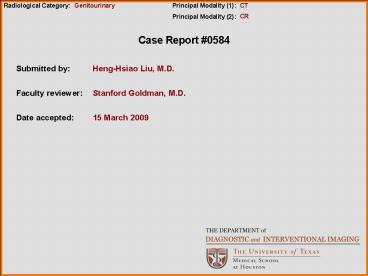Case Report - PowerPoint PPT Presentation
1 / 21
Title:
Case Report
Description:
40 year old male with no past medical history status post motor vehicle collision. ... ureteral meatus later in life may also precede the development of a ureterocele. ... – PowerPoint PPT presentation
Number of Views:3322
Avg rating:3.0/5.0
Title: Case Report
1
Radiological Category
Principal Modality (1) Principal Modality (2)
Genitourinary
CT
CR
Case Report 0584
Submitted by
Heng-Hsiao Liu, M.D.
Faculty reviewer
Stanford Goldman, M.D.
Date accepted
15 March 2009
2
Case History
- 40 year old male with no past medical history
status post motor vehicle collision.
3
Radiological Presentations
Coronal enhanced CT
4
Radiological Presentations
Delayed axial enhanced CT
5
Test Your Diagnosis
Which one of the following is your choice for the
appropriate diagnosis? After your selection, go
to next page.
- Transitional cell carcinoma
- Ureterocele
- Urinary calculus
- Bladder diverticulum
6
Additional Images
Oblique pelvic radiograph during contrast
excretion
7
There is cystic dilatation and telescoping of the
distal left ureter into the bladder, best seen on
delayed images, with proximal hydronephrosis of
the left kidney. No calculus or soft tissue
density is identified at the ureteropelvic
junction. Pelvic radiograph revealed the classic
cobra head sign, a contrast-filled ureter
draining into the bulbous dilatation of its
distal end with a surrounding radiolucent halo
seen within the bladder. These findings are
consistent a simple ureterocele.
Findings
8
Differentials
- Transitional cell carcinoma
- Urinary calculus
- Bladder diverticulum
- Urachal cyst
9
Discussion
- A ureterocele is defined as a cystic dilatation
of a prolapsed, intravesical segment of the
distal ureter. This may be due to a congential
narrowing of the ureteral meatus, which then
dilates and eventually prolapses into the
bladder. Inflammation or trauma leading to
fibrosis of the ureteral meatus later in life may
also precede the development of a ureterocele.
Adult-type ureteroceles are more common in women.
Fig 1. Simple uretocele. Berrocal et. al. (1)
10
Discussion
- Ureteroceles are classified as simple or ectopic.
- In simple ureteroceles, the orifce of the ureter
and the ureterocele itself are intravesical. They
are incidental findings in asymptomatic adult
patients, but when large, they can cause
obstruction of the bladder neck along with
obstruction of the ipsilateral ureter. - The ectopic ureterocele lies within the submucosa
of the bladder, and some part of it may extend
into the bladder neck or urethra. It is usually
diagnosed in childhood and almost always seen in
association with duplex ureters, typically
arising from the upper pole ureter.
Fig. 2. Prolapsed ureterocele. Berrocal et. al.
(1)
11
Discussion
- Fig. 3. Sonographic findings are characteristic,
usually seen as a rounded, sonolucent mass with
echogenic walls that projects into the bladder. - Berrocal et. al. (1)
12
Discussion
- An important differential consideration is
pseudoureterocele, which is defined as an
incomplete distal ureteral obstruction associated
with a tumor or calculus. Stone impaction at the
ureteropelvic junction with surrounding edema or
tumor overgrowth at the distal ureter may both
present with the classic cobra head sign.
Therefore, one must carefully inspect the
cobras hood for focal areas of thickening,
irregularity, or loss of definition. Other
suspicious findings include irregularities of the
bladder wall, moderate to severe obstruction of
the proximal ureter, or stones elsewhere in the
urinary tract. - Cystoscopic evaluation may be helpful in
difficult cases.
Fig. 4. Impacted ureteral stone. Dyer et. al. (3)
Fig. 5. Transitional cell carcinoma. Dyer et. al.
(3)
13
Additional Images
Axial CT Lung Window
14
Additional Images
Axial CT Lung Window
15
Additional Images
Axial enhanced CT
16
Additional Images
Cystogram
17
CT revealed a small amount of free air in the
abdomen and a tiny amount of free fluid in the
pelvis. The bladder was decompressed with a Foley
but otherwise unremarkable. No pelvic fractures
were identified. A cystogram performed to
work-up the patients hematuria revealed
intraperitoneal bladder rupture.
Intraoperatively, no bowel injury was seen. It is
suspected that the Foley drained most of the free
fluid in the pelvis and introduced a small amount
of air.
Findings
18
Discussion
- Bladder injury may result from blunt or
penetrating trauma, and the propensity for
rupture is related to the degree of distension at
the time of impact. Delayed diagnosis may
significantly increase mortality. - Bladder injury is classified into five types
- 1 Contusion
- 2 Intraperitoneal
- 3 Interstitial
- 4 Extraperitoneal
- 5 Combined intraperitoneal and extraperitoneal
Fig. 6. Type 2 bladder rupture. Vaccaro et. al.
(4)
19
Discussion
- Types 1 3 are managed conservatively type 4
needs catheter drainage types 2 5 require
surgical treatment. - CT with intravenous contrast is inadequate to
diagnose bladder injury as there is inadequate
distension from the antegrade flow of contrast
from the ureters. - A retrograde cystogram or CT cystography can be
performed to assess for bladder injury, which may
be suspected in the presence of pelvic fractures,
intraperitoneal free fluid, or gross hematuria.
Fig. 7. Contrast between bowel loops in a type 2
bladder injury. Vaccaro et. al. (4)
20
Intraperitoneal Bladder Rupture with Left Simple
Ureterocele
Diagnosis
21
1. Chavhan GB. The cobra head sign. Radiology.
2002 Dec225(3)781-2. 2. Berrocal T,
López-Pereira P, Arjonilla A, Gutiérrez J.
Anomalies of the distal ureter, bladder, and
urethra in children embryologic, radiologic, and
pathologic features. Radiographics. 2002
Sep-Oct22(5)1139-64. 3. Dyer RB, Chen MY,
Zagoria RJ. Classic signs in uroradiology.
Radiographics. 2004 Oct24 Suppl 1S247-80.4.
Vaccaro JP, Brody JM. CT cystography in the
evaluation of major bladder trauma.
Radiographics. 2000 Sep-Oct20(5)1373-81. 5.
Sandler CM, Hall JT, Rodriguez MB, Corriere JN
Jr. Bladder injury in blunt pelvic trauma.
Radiology. 1986 Mar158(3)633-8.
References































